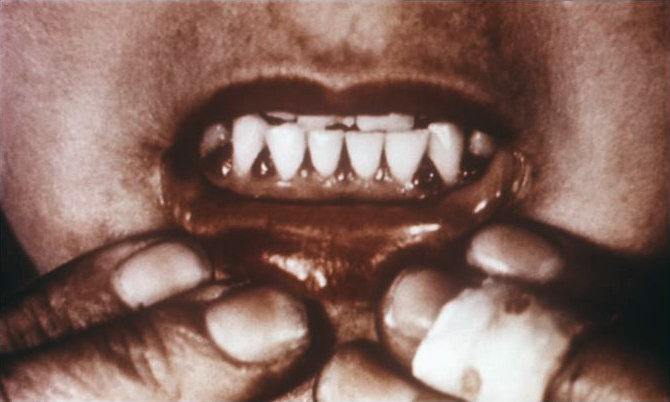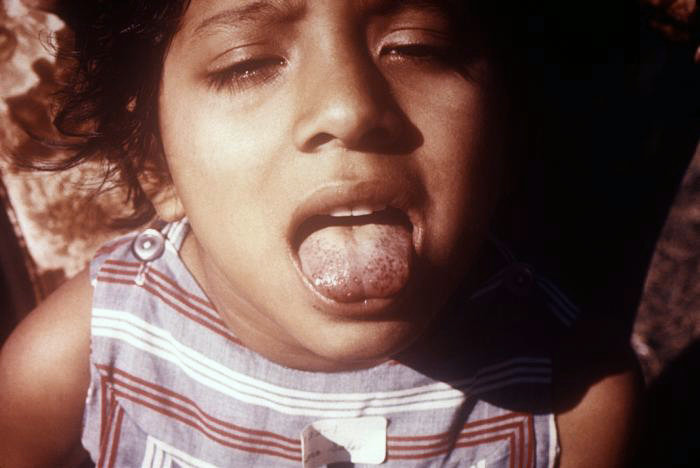Scurvy
 From Wikidoc - Reading time: 8 min
From Wikidoc - Reading time: 8 min
|
WikiDoc Resources for Scurvy |
|
Articles |
|---|
|
Media |
|
Evidence Based Medicine |
|
Clinical Trials |
|
Ongoing Trials on Scurvy at Clinical Trials.gov Clinical Trials on Scurvy at Google
|
|
Guidelines / Policies / Govt |
|
US National Guidelines Clearinghouse on Scurvy
|
|
Books |
|
News |
|
Commentary |
|
Definitions |
|
Patient Resources / Community |
|
Directions to Hospitals Treating Scurvy Risk calculators and risk factors for Scurvy
|
|
Healthcare Provider Resources |
|
Continuing Medical Education (CME) |
|
International |
|
|
|
Business |
|
Experimental / Informatics |
Editor-In-Chief: C. Michael Gibson, M.S., M.D. [1]; Associate Editor(s)-in-Chief:
| Scurvy | |
 | |
|---|---|
| Scorbutic gums, a symptom of scurvy | |
| ICD-10 | E54 |
| ICD-9 | 267 |
| OMIM | 240400 |
| DiseasesDB | 13930 |
| MedlinePlus | 000355 |
| eMedicine | med/2086 derm/521 ped/2073 radio/628 |
| MeSH | D012614 |
Overview[edit | edit source]
Scurvy (N.Lat. scorbutus) is a deficiency disease that results from insufficient intake of vitamin C, which is required for correct collagen synthesis in humans. The scientific name of vitamin C, ascorbic acid, is derived from the Latin name of scurvy, scorbutus. Scurvy leads to the formation of liver spots on the skin, spongy gums, and bleeding from all mucous membranes. The spots are most abundant on the thighs and legs, and a person with the ailment looks pale, feels depressed, and is partially immobilized. In advanced scurvy there are open, suppurating wounds and loss of teeth.
Scurvy was at one time common among sailors, pirates and others who were on ships that were out to sea longer than perishable fruits and vegetables could be stored and by soldiers who were similarly separated from these foods for extended periods. It was described by Hippocrates (c. 460 BC–c. 380 BC). Its cause and cure have been known in many native cultures since prehistory. For example, in 1536, the French explorer Jacques Cartier, exploring the St. Lawrence River, used the local natives' knowledge to save his men who were dying of scurvy. He boiled the needles of the arbor vitae tree (Eastern White Cedar) to make a tea that was later shown to contain 50 mg of vitamin C per 100 grams.[1][2] However it was a Scottish surgeon in the British Royal Navy, James Lind (1716–1794) who first proved it could be treated with citrus fruit in experiments he described in his 1753 book, A Treatise of the Scurvy.
In infants, scurvy is sometimes referred to as Barlow's disease, named after Sir Thomas Barlow (1845–1945),[3] a British physician who described it. (N.B. Barlow's disease may also refer to mitral valve prolapse.) Other eponyms include Moeller's disease and Cheadle's disease.
Scurvy or subclinical scurvy is caused by the lack of vitamin C. In modern western society, scurvy is rarely present in adults, although infants and elderly people are affected.[4] Vitamin C is destroyed by the process of pasteurization, so babies fed with ordinary bottled milk sometimes suffer from scurvy if they are not provided with adequate vitamin supplements. Virtually all commercially available baby formulas contain added vitamin C for this reason; however heat and storage destroy vitamin C. Human breast milk contains sufficient vitamin C, if the mother has an adequate intake to prevent scurvy on her own.
Scurvy is one of the accompanying diseases of malnutrition (other such micronutrient deficiencies are beriberi or pellagra) and thus is still widespread in areas of the world depending on external food aid.[5] Though rare, there are also documented cases of scurvy due to poor dietary choices by people living in industrialized nations.[6]
Historical Perspective[edit | edit source]
Scurvy was probably first observed as a disease by Hippocrates.[7] In the 13th century the Crusaders suffered from scurvy frequently, and it has inflicted terrible losses on both besieged and besieger in times of war. Scurvy was one of the limiting factors of marine travel, often killing large numbers of the passengers and crew on long-distance voyages. It even played a significant role in World War I.
The British civilian medical profession of 1614 knew that it was the acidic principle of citrus fruit which was lacking, although they considered any acid as acceptable when ascorbic acid (Vitamin C) was unavailable. In 1614 John Woodall (Surgeon General of the East India Company) published his book "The Surgion's Mate" as a handbook for apprentice surgeons aboard the company's ships. In it he described scurvy as resulting from a dietary deficiency. His recommendation for its cure was fresh food or, if not available, oranges, lemons, limes and tamarinds, or as a last resort, Oil of Vitriol (sulfuric acid).[8]
In 1734, the Leiden-based physician Johann Bachstrom published a book on scurvy in which he stated that "scurvy is solely owing to a total abstinence from fresh vegetable food, and greens; which is alone the primary cause of the disease." and urged the use of fresh fruit and vegetables as a cure. However, it was not until 1747 that James Lind formally proved that scurvy could be treated and prevented by supplementing the diet with citrus fruit such as lemons and lime. Although James Cook succeeded in circumnavigating the world (1768-71) in HM Bark Endeavour without losing a single man to scurvy, his suggested methods, including a diet of sauerkraut and wort of malt, did not reproduce his success, and British sailors throughout the American Revolutionary period continued to suffer from scurvy, particularly in the Channel Fleet. The eradication of scurvy from the Royal Navy was finally due to the chairman of the Navy's Sick and Hurt Board, Gilbert Blane, who finally put Bachstrom and Lind's long-ignored prescription of fresh lemons to use during the Napoleonic Wars. Other navies soon adopted this successful solution.[8]
The plant known as "scurvy grass" acquired its name from the observation that it cured scurvy, but this was of no great help to those who spent months at sea. During sea voyages, it was discovered that sauerkraut was of extremely limited use in preventing scurvy. In the Royal Navy's Arctic expeditions in the 19th century it was widely believed that scurvy was prevented by good hygiene on board ship, regular exercise, and maintaining the morale of the crew, rather than by a diet of fresh food, so that Navy expeditions continued to be plagued by scurvy even while fresh meat was well-known as a practical antiscorbutic among civilian whalers and explorers in the Arctic. At the time Robert Falcon Scott made his two expeditions to the Antarctic in the early 20th century, the prevailing medical theory was that scurvy was caused by "tainted" canned food. It was not until 1932 that the connection between vitamin C and scurvy was established.
The use of limes by the Royal Navy to prevent scurvy gave rise to the name "limey" for a British sailor, which has been since extended to all British in American slang.
Classification[edit | edit source]
Pathophysiology[edit | edit source]
Normal collagen synthesis depends upon the hydroxylation of proline and lysine residues in the endoplasmic reticulum, to form hydroxyproline and hydroxylysine, respectively. Prolyl and lysyl hydroxylase, the enzymes that catalyze the hydroxylation, require ascorbic acid (vitamin C) to function correctly. With no ascorbic acid, the enzymes cannot hydroxylate proline and lysine, and so normal collagen synthesis cannot be performed.
Causes[edit | edit source]
Differentiating Scurvy from Other Diseases[edit | edit source]
- Advanced age
- Alcoholism
- Mental illness
- Infant on processed milk without supplementation
- Unusual diet habits
- Osteoporosis
- Idiopathic transient osteoporosis of hip
- Osteomalacia
- Osteogenesis imperfecta
- Multiple myeloma
- Homocystinuria
- Hypermetabolic resorptive osteoporosis.
|
Epidemiology and Demographics[edit | edit source]
Risk Factors[edit | edit source]
Screening[edit | edit source]
Natural History, Complications, and Prognosis[edit | edit source]
Natural History[edit | edit source]
complications[edit | edit source]
Prognosis[edit | edit source]
Untreated scurvy is invariably fatal. However, since all that is required for a full recovery is the resumption of normal vitamin C intake, death from scurvy is rare in modern times.
Diagnosis[edit | edit source]
Diagnostic Criteria[edit | edit source]
History and Symptoms[edit | edit source]

- Dark purplish spots on skin, especially legs.
- spongy gums, often leading to tooth loss.
- bleeding from all mucous membranes.
- Pallor.
- Bleeding gums.
- Sunken eyes
- Opening of healed scars and separation of knitted bone fractures.
Physical Examination[edit | edit source]
Laboratory Findings[edit | edit source]
Imaging Findings[edit | edit source]
Other Diagnostic Studies[edit | edit source]
Treatment[edit | edit source]
Medical Therapy[edit | edit source]
Surgery[edit | edit source]
Prevention[edit | edit source]
Scurvy can be prevented by a diet that includes certain citrus fruits such as oranges or lemons. Other good sources of vitamin C are fruits such as blackcurrants, guava, kiwi, papaya, tomatoes and strawberries. It can also be found in some vegetables, such as bell peppers, broccoli, potatoes, cabbage, spinach and paprika, as well as some pickled vegetables. Though redundant in the presence of a balanced diet,[9] various nutritional supplements are available that provide ascorbic acid well in excess of that required to prevent scurvy,[10] and even some candies contain vitamin C.[11]
See also[edit | edit source]
- Scurvy-grass
References[edit | edit source]
- ↑ Jacques Cartier's Second Voyage , 1535 Winter & Scurvy
- ↑ Jacques Cartier witnesses a treatment for scurvy. NCBI Pb Med, 2002 Jun, Martini E.
- ↑ "Medical History - Infantile scurvy: the centenary of Barlow's disease" (PDF). British Medical Journal. 287. December 17, 1983.
- ↑ Hampl JS, Taylor CA, and Johnston CS. (2004). "Vitamin C Deficiency and Depletion in the United States: The Third National Health and Nutrition Examination Survey, 1988 to 1994". American Journal of Public Health. 94 (5): 870–875. PMID 15117714.
- ↑ Template:Cite paper
- ↑ Davies IJ, Temperley JM (1967). "A case of scurvy in a student". Postgraduate Medical Journal. 43 (502): 549–50. PMID 6074157.
Sthoeger ZM, Sthoeger D. Scurvy from self-imposed diet. Harefuah. 1991 Mar 15;120(6):332-3.
Ellis CN, Vanderveen EE, Rasmussen JE. Scurvy. A case caused by peculiar dietary habits. Arch Dermatol. 1984 Sep;120(9):1212-4.
McKenna KE, Dawson JF. Scurvy occurring in a teenager. Clin Exp Dermatol. 1993 Jan;18(1):75-7. - ↑ Stone, Irwin (1966). "On the Genetic Etiology of Scurvy". Acta Geneticae Medicae et Gemellologiae. 15: 345–350.
- ↑ 8.0 8.1 Bown, Stephen R. "SCURVY: How a Surgeon, a Mariner and a Gentleman Solved the Greatest Medical Mystery of the Age of Sail", Viking 2003
- ↑ Rivers, Jerry M., "Safety of High-level Vitamin C Ingestion", Annals of the New York Academy of Sciences, 498 (1): 445–454
- ↑ Nutrition information for "Emergen-C" product
- ↑ Nutrition information for "Halls Defense" product
Template:Nutritional pathology
bg:Скорбут cs:Kurděje da:Skørbug de:Skorbut el:Σκορβούτο eo:Skorbuto io:Skorbuto is:Skyrbjúgur it:Scorbuto he:צפדינה hu:Skorbut mk:Скорбут nl:Scheurbuik no:Skjørbuk nn:Skjørbuk simple:Scurvy sk:Skorbut sr:Скорбут fi:Keripukki sv:Skörbjugg
 KSF
KSF